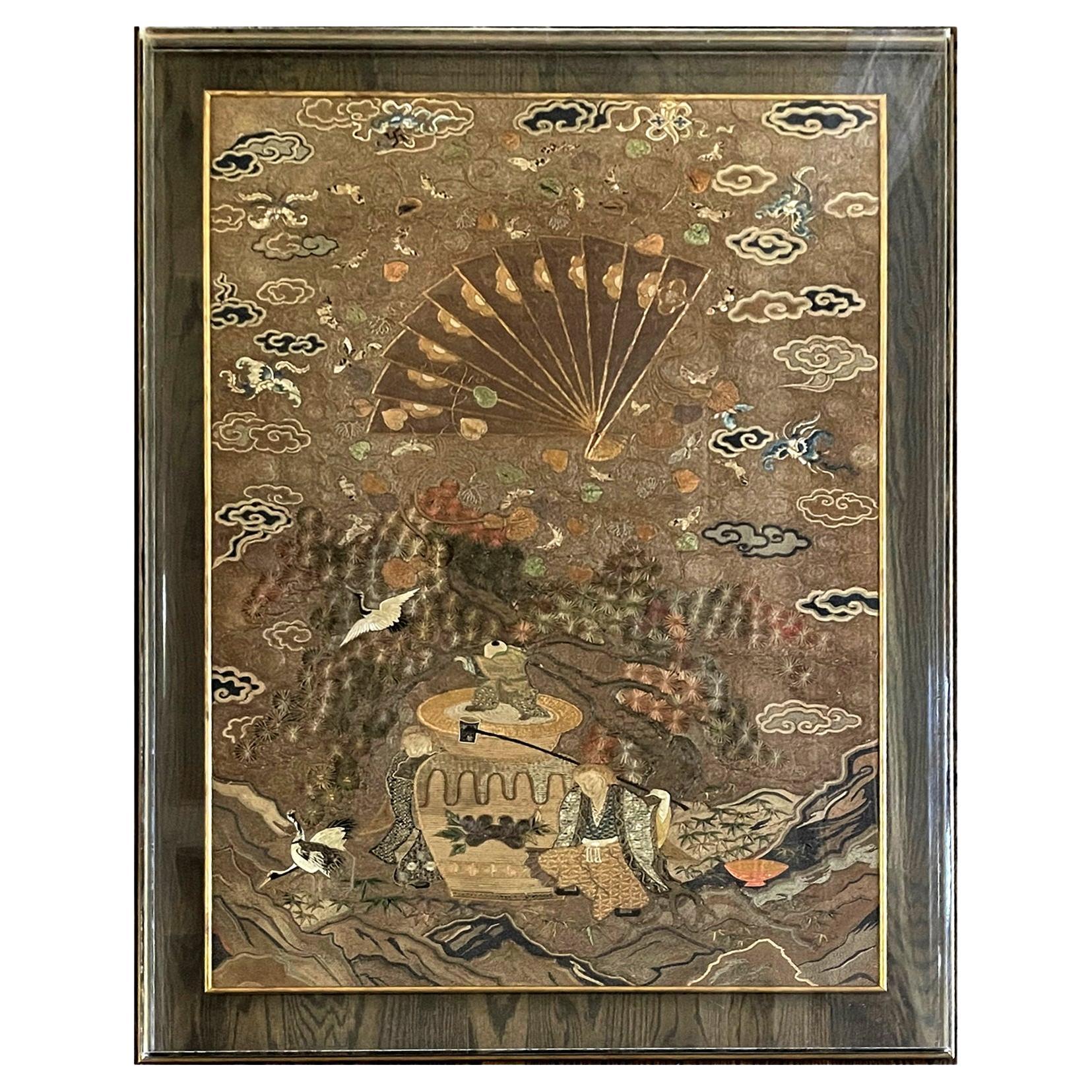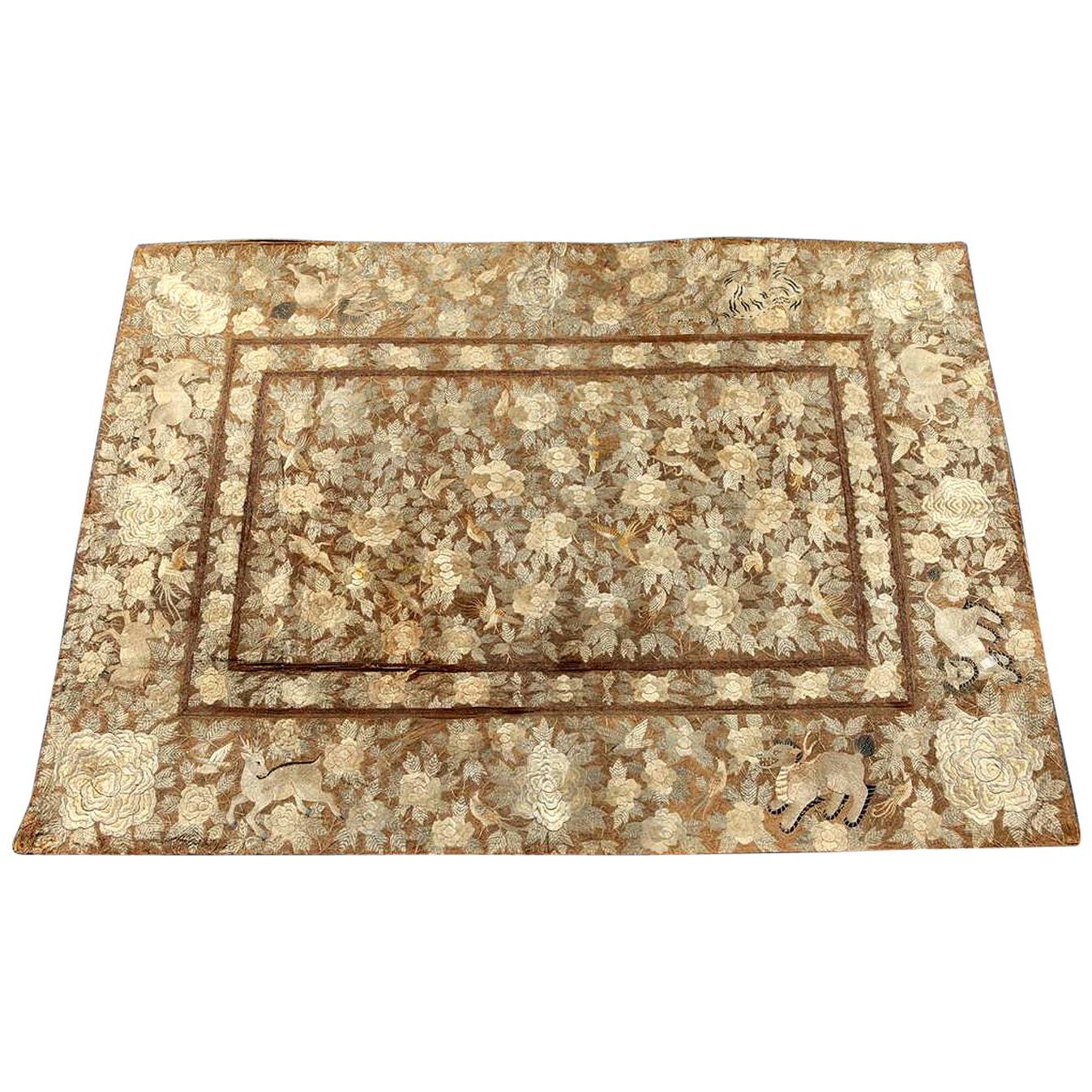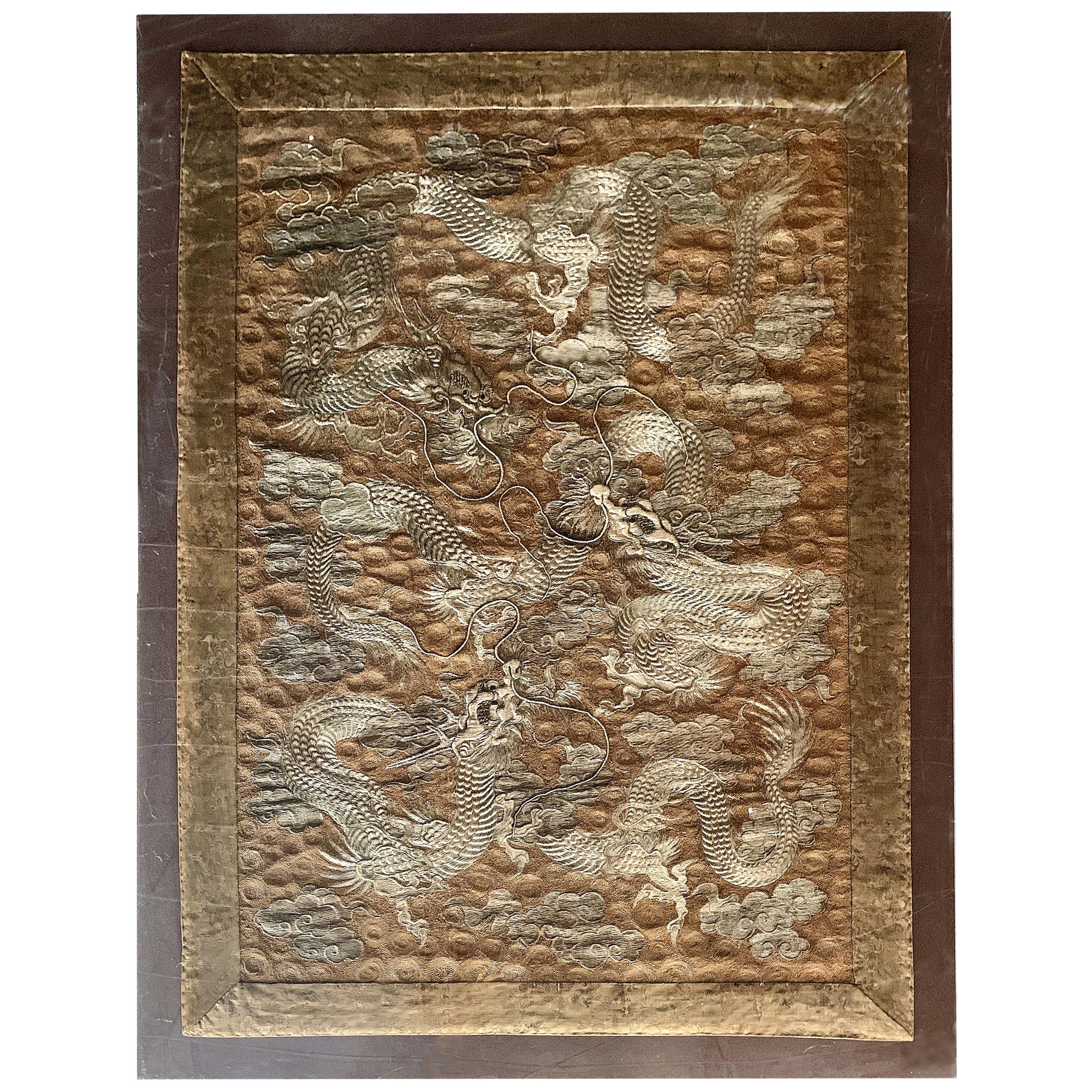Items Similar to Framed Japanese Antique Embroidery Sennin Tapestry Meiji Period
Want more images or videos?
Request additional images or videos from the seller
1 of 18
Framed Japanese Antique Embroidery Sennin Tapestry Meiji Period
About the Item
A stunning Japanese embroidery tapestry circa 1880s-1900s from late Meiji period, presented with an original wood frame with inner gold trim. The tour-de-force embroidered tapestry showcases a dramatic pictorial in which Tekkai Sennin intertwines with a slithering dragon in the air and releases swirl spirit wind from his bottle. This scenery alludes to a deity adapted in Japan from the Chinese prototype called Li Tieguai. Literally translated as Li the Iron Crutch, he was one of the eight immortals in Chinese Taoism folklore. He is often depicted as a limp and disheveled old man walking on a crush and holding a Calabash gourd. In both Chinese and Japanese culture, he was beloved and worshipped due to his compassion for the poor and the sick as he used the medicine in his bottle to alleviate the pain of the diseased. In Japanese art, he was often depicted with holding his gourd bottle, from which a tornado like vapor emanates. The swirl clouds represent his own soul. Many paintings of such subject manner can be found in museum collections around the world.
The tapestry on offer was entirely hand-embroidered and the superb craftsmanship is evident with the first glimpse. The composition is striking and was painstakingly executed by the unknown artisans. The high relief effect, created by meticulous techniques such as satin stiches, couching and piling with layers of gold and silver wrapped threads, displays a harmonious composition while conveying a livid sense of motion (especially the swirling clouds). The attention to details was rather meticulous, down to the rendition of the background thatch houses, landscapes, trees by the stream, and the little medallions in the sky. It also appears that it was kept in very good condition under the frame. All these factors set the piece apart as a highly collectible textile art.
Japanese textiles from Meiji period were widely exhibited in the west during turn of the 20th century at the international expositions. It was used to showcase the Japanese aesthetics with the techniques at their pinnacle. These expositions solidified the country's images overseas and fueled the Japonisme craze in the west, which turned out to be a long-lasting influence on the western art. Many pieces were purchased and stayed in the west. It is likely this estate piece was from one of the expositions based on its high quality. Remanent of a paper label on the back as shown.
Japanese figurative embroidery tapestries are relatively less common. For a tapestry of Kari Sonja, see "Threads of silk and gold ornamental textile from Meiji Japan Ashmolean", page 97.
A tapestry of that depicts Badara Sonja see "Re-envisioning Japan Meiji Fine Art Textile, John E. Vollmer", page 90.
For detailed terminology of embroidery techniques used in this work, please refer to threads of silk and gold ornamental textile from Meiji Japan Ashmolean page 86-87.
- Dimensions:Height: 57 in (144.78 cm)Width: 38 in (96.52 cm)Depth: 1.2 in (3.05 cm)
- Style:Meiji (Of the Period)
- Materials and Techniques:
- Place of Origin:
- Period:
- Date of Manufacture:1880s-1910s
- Condition:Wear consistent with age and use. Textile appears very fine, not examined out of the frame. Frame shows age-related wear including minor nicks and scratches. Small punctures and scrapes on the backing paper.
- Seller Location:Atlanta, GA
- Reference Number:1stDibs: LU945036493992
About the Seller
5.0
Platinum Seller
These expertly vetted sellers are 1stDibs' most experienced sellers and are rated highest by our customers.
Established in 2006
1stDibs seller since 2010
478 sales on 1stDibs
Typical response time: <1 hour
- ShippingRetrieving quote...Ships From: Atlanta, GA
- Return PolicyA return for this item may be initiated within 2 days of delivery.
More From This SellerView All
- Framed Japanese Antique Phoenix Dragon Embroidery Tapestry Meiji PeriodLocated in Atlanta, GAA visually stunning Japanese embroidery tapestry circa 1890s-1900s late Meiji period, presented with a linen matt with gold trim in a gilt wood frame. The design showcases a flying p...Category
Antique 1890s Japanese Japonisme Textiles
MaterialsSilk, Giltwood
- Large Japanese Embroidery Tapestry Meiji PeriodLocated in Atlanta, GAA large and finely embroidered Japanese tapestry with brocade border, circa 1900s Meiji period. The tapestry depicts, in a rather realistic style, a forested landscape in autumn flan...Category
Early 20th Century Japanese Japonisme Textiles
MaterialsBrocade, Silk
- Japanese Silk Embroidery Tapestry Meiji PeriodLocated in Atlanta, GAA spectacular Japanese embroidered silk panel beautifully presented in a gilt frame suspended in a lucite shadow box with gilt wood border. The silk picture is dated to 1890-1910s toward the end of Meiji Period, when Japanese started to participate international expose by presenting its best art and craft. Elaborate embroidered silk tapestry like this was very popular among westerners due to its superb craftmanship and also exotic subject matter that was often derived from classic Japanese folklore, mythology and various motifs. The tapestry on offer is such an example. It depicts an old couple...Category
Antique 1890s Japanese Japonisme Textiles
MaterialsFabric, Silk, Lucite
- Massive Japanese Embroidery Tapestry Display Box Meiji PeriodLocated in Atlanta, GAA massive Japanese embordered tapestry professionally displayed in a custom acrylic shadow box. The fine work of textile art is dated to 1890-1920s, late Meiji (1868-1912) or possibl...Category
Early 20th Century Japanese Japonisme Textiles
MaterialsBrocade, Silk, Acrylic
- Antique Japanese Embroidery TapestryLocated in Atlanta, GAA large Japanese silk embroidery tapestry circa 19th century, late Edo to early Meiji period. Meticulously handwork that densely depicts repea...Category
Antique 19th Century Japanese Japonisme Textiles
MaterialsSilk
- Large Framed Japanese Embroidery Dragon TapestryLocated in Atlanta, GAAn impressive Japanese embroidery tapestry circa 1890s Meiji period, presented with brocade border on linen canvas in a Lucite shadow box. The stunning design features three dragons coiling and flying in the clouds. The high relief technique used to render the dragons using mostly the silver threads gives this piece a tremendous sense of motion. The most auspicious mythological creature in Japan and China, dragons were a very popular motif in textile art. In this particular piece, it is the impressive size, the superb craftsmanship, the profuse use of silver threads and near perfect condition that set it apart. Japanese Meiji textiles were widely exhibited in the west during turn of the 20th century at the international exposition. It was used to showcase the Japanese aesthetics with the techniques at their pinnacle. These expositions solidified the country's images overseas and felled the Japanese craze in the west, which turned out to be a long-lasting influence on the western art. Many pieces were purchased and stayed in the west. It is likely this estate piece was from one of the expositions based on its high quality. For two similar dragon tapestries...Category
Antique 1890s Japanese Japonisme Textiles
MaterialsTextile, Lucite
You May Also Like
- Meiji Period Japanese Indigo Double Ikat Futon CoverLocated in Point Richmond, CAMeiji period Japanese Indigo double ikat futon cover Japanese futon cover, a double ikat pattern in four panels depicting Kumamoto Castle with im...Category
Antique 1890s Japanese Meiji Textiles
MaterialsCotton
- Antique Early 20th Century Japanese Hand Stitched Silk Framed TapestryLocated in Lambertville, NJAll hand work framed silk Japanese tapestry with embroidered boarder. A deep custom black lacquered frame. Originaly sold from Newman Galleries....Category
Early 20th Century Japanese Meiji Textiles
MaterialsSilk, Glass, Lacquer
- Late Meiji Period Sleeping Kimono / Yogi, JapanLocated in Point Richmond, CALate Meiji Period sleeping Kimono / Yogi, Japan Yogi are a type of oversized sleeping kimono traditionally used in Japan. This kimono would have b...Category
Early 20th Century Japanese Tribal Textiles
MaterialsCotton
- Susani Uzbek Embroidery TapestryLocated in Alessandria, PiemonteOld very elegant "susani" from Uzbekistan - not too large, it's perfect for wall like a picture or a tapestry; else placed on a table or on the back of a sofa. ref. B/2433.Category
21st Century and Contemporary Uzbek Other Textiles
MaterialsSilk
- Antique Kalagas Burmese Wall Tapestry set in a Custom Newer FrameLocated in Douglas Manor, NY3797 Folk Art wall decoration /tapestry Hand sewn with beaded sequins and glass balls on dyed cloth Mounted on acrylic panel with gilt wood frame(old piece mounted at later date) Ta...Category
Antique 19th Century Asian Tapestries
MaterialsFabric, Acrylic, Beads
- Japanese Indigo Dyed Old Embroidery Cloth / Japanese Toy Pattern / 1912-1960Located in Sammu-shi, ChibaIt is a Japanese indigo dyed antique cloth. It calls its name "fu-ro-shi-ki". Originally used in the dressing room of the public bath "furo" during the...Category
Early 20th Century Japanese Showa Textiles
MaterialsCotton
Recently Viewed
View AllMore Ways To Browse
Antique Medicine Bottles
Chinese Gold Dragon Embroidery
Antique Textile From Japan
Japanese Silk Relief Embroidery
Chinese Surcoat
Japanese Farmer Jacket
Antique Ottoman Vest
Indian Wedding Tuxedo
Indonesian Dyed Silk Lawon
Japan Silk Embroidered Scenery
Kesi Panel
Suzani Coat
Tofu Japan
Yogi Kimono
10 Ft Suzani
799 Tapestry
Antique Chinese Incent Burner
Galbraith Paul





